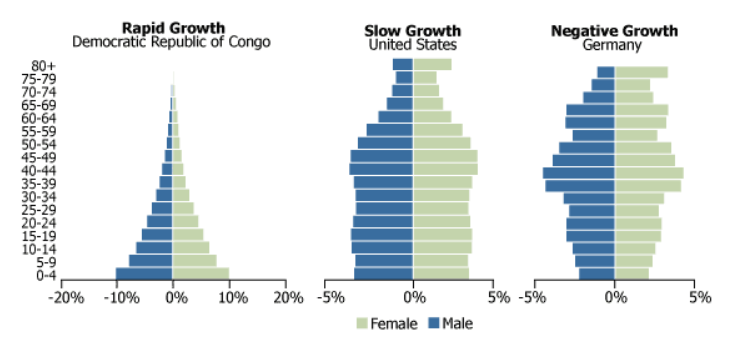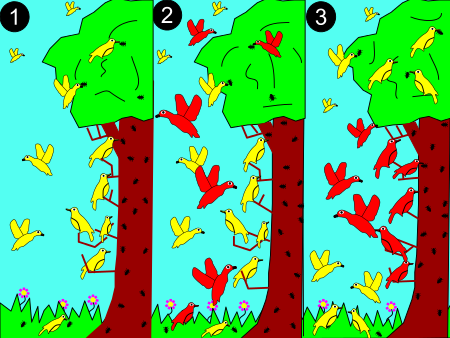Population Ecology Study Guide
Introduction:
Population ecology studies the density, distribution, size, sex ration, and age structure of populations. It is the branch of biology that deals with the number of individuals of a particular species that are found in an area and how and why those numbers change ove time.
Populations have certain properties, such as birth rates and death rates, that individual organisms lack. Population density is the number of individuals of a species per unit of area or volume at a given time. Understanding this topic can help answer questions like how the changes in free energy available to organisms result in changes to population size and disruptions to an ecosystem or how biological systems from cells to organisms to populations, communities, and ecosystems affected by complex biotic and abiotic interactions involving exchange of matter and free energy?
Population Ecology:
1. Explain how density, dispersion, and demographics describe a population.
- Density is the number of individuals per unit of square area
- Dispersion describes the arrangement of individuals in the population
- Random dispersion: Dispersion is not limited by area, and there is no competition for space. One of the few examples is how dandelion and other plants that have wind-blown seeds germinate.
- Uniform dispersion: Dispersion is limited by space, and organisms maintain an equal distance from each other, each in their own territory. An example would be wolves.
- Clumped dispersion: Organisms clump together for a variety of reasons, be it protection, feeding, habitat, or something else. Think herds of elephants or schools of fish here.
- Demographics show the age structure, birth and death rates, and sex rations for a human population, often separated by country. It can be helpful for predicting what a population will look like in the future. Known as “population pyramids”, those with a wide base can expect rapid growth in the future. Alternatively, those with even distributions tend to have slower population growth. Those with a significant number of working age individuals can expect a very large elderly population, with fewer in the workforce to support them. Don’t worry about knowing more than this, demography has its own whole area of study!
- Species richness refers to the total number of species in a given area
- Species diversity, on the other hand, refers to the population size of each species in a given area
2. What are the differences between exponential and logistic models of population growth?
- Exponential models assume that the population will keep growing at an increasingly faster rate, without stopping, because there is no limit of density. This graph forms a J curve.
- Logistic models assume a carrying capacity for the population, where population growth slows and eventually plateaus as it reaches the maximum number of individuals the environment can support. This forms an S curve.
- The S curve can be modelled by the equation (K – carrying capacity; N – no. of individuals):

- Important parts of the equation to know: dN/dT tells us that this is for any given point in the population’s growth, at that exact time (this is a derivative- if you haven’t studied derivatives, don’t worry!), there are (K-N) individuals that can be added to the population before it reaches the carrying capacity. (K-N)/K gives a fraction for the carrying capacity, and this will reduce the growth rate once the carrying capacity has been reached.
3. Density-dependent and density-independent factors can control population growth.
- Density dependent factors limit the population as a result of changing population densities. Death rates are proportional to density, while birth rates are inversely proportional. Examples of density-dependant factors include competition, predation, disease, and parasites: higher density of individuals of a species increases competition, predation, diseases, and parasites, lowering the population.
- Density independent factors limit space for organisms regardless of how many individuals there are- birth and death rates are not impacted by the density. Examples include natural disasters and climate changes.
4. Explain how changes in matter or energy can change the population and community.
- Energy (sunlight) is converted to matter as plants. Per the 10% rule, only 10% of energy is passed up trophic levels- primary consumers, those who eat plants, get 10% of the energy of the plant matter they consumed. Secondary consumers, those who eat the primary consumers, get 10% of the energy of the primary consumers they consume. This puts a limit on the number of trophic levels an ecosystem can support.
- A change in energy, which has a proportional change in matter, also has a proportional impact on the ecosystem: More energy = more matter = a larger population can be supported
Community Ecology:
1. Explain the difference between a fundamental niche and a realized niche.
- A realized niche is the species that an organism will interact with. This includes what it eats, what it has ecological relationships with (see below) and where it will take shelter, among others.
- The fundamental niche is the possible interactions an organism could have in their environment. All organisms in a realized niche are part of the fundamental niche, but only those the organism interacts with are in the realized niche.
2. Explain the idea of competition between different species and members of the same species.
- Interspecific competition describes competition between different species for some limited resource(s).
- Intraspecific competition is the competition between members of the same species. There may be competition for mates, resources, and habitats. All of this can lead to adaptations among a species.
3. Be able to explain the role of competitive exclusion in interspecific competition.
- If organisms have the same or similar niches in the same place, they cannot permanently coexist. A slight advantage of one species will eventually make the inferior species go extinct
- One (or both) of the species may adapt to survive in a different niche. This is called resource partitioning.
4. Know the different possible types of relationships between species in an ecosystem.
- Predation: One organism benefits, the other is killed.
- An example of predation in an ecosystem: Owls eating mice.
- Parasitism: One organism benefits, the other is hurt or weakened, but not killed.
- An example of parasitism in an ecosystem: a tick sucking the blood of humans.
- Commensalism: One organism benefits, the other is unaffected.
- An example of commensalism in an ecosystem: Cattle egrets, small birds that ride the backs of cattle and wait for them to stir up insects in vegetation, get food while the cattle are unaffected.
- Mutualism: Both species benefit from the interaction.
- An example of mutualism in an ecosystem: The Egyptian Plover bird frequently cleans the teeth of crocodiles. The Plover gets a meal, and the crocodile gets clean teeth.
5. Identify and explain the role of keystone species in an ecosystem and on community structure.
- A keystone species is a species on which other species in the ecosystem largely depend on. If that species is removed, there would be drastic changes to the ecosystem.
- The addition or removal of a keystone species can significantly increase or decrease populations of other animals, as well as change the biotic factors of the ecosystem. For example, when wolves were reintroduced into the Yellowstone area, they greatly controlled the deer population that had been eating leaves of trees. With fewer deer, the trees grew stronger, which helped to strengthen the banks of rivers and even changed their course.
6. Explain the difference between primary and secondary succession.
- Primary succession occurs when a rocky area is transformed into an ecological community. This takes thousands of years, and it is initiated by micro photosynthetic organisms colonizing the rock area. Soil and plants follow, and finally animals.
- Secondary succession occurs when an area recovers from a natural disaster. This wipes out many previous species and allows new ones to enter the area. An example of this would be forest fires causing many trees to die. However, the heat can cause some seeds to open and germinate, resulting in new growth.
- Climax community succession usually occurs after secondary succession, and describes an environment that is fully functional and self-supporting. There is a wide variety of plants and animals.
Conclusion
- Population ecology studies the density, distribution, size, sex ration, and age structure of populations.
- Primary succession occurs in an environment without previous life, or a barren habitat. Secondary succession occurs in an area that had previously been inhabited but experienced a disturbance, such as a wildfire.
- A keystone species is an organism that helps define an entire ecosystem.
- Five types of relationships can be characterized based on the interaction between organisms within or between overlapping niches. They are — competition, predation, commensalism, mutualism and parasitism.
FAQs
1. What is population ecology?
It is the branch of biology that deals with the number of individuals of a particular species that are found in an area and how and why those numbers change ove time.
2. Why is ecology studied at the population level or higher?
Populations have certain properties, such as birth rates and death rates, that individual organisms lack.
3. What is lambda in population ecology?
Rate of growth (lambda) is the ratio of population size at the end of one interval to population size at the end of the previous interval.
4. What is population dynamics ecology?
Population dynamics is the portion of ecology that deals with change of populations of a species over time.
5. How is human population ecology different than population ecology of other organisms?
- Humans can deliberately regulate their fertility.
- Human populations are not limited by natural resources.
- The nutritional requirements of humans are unique in the animal kingdom.
6. In the study of ecology, what is a population?
In ecology, population refers to all the members of a particular species that live together in the same area at the same time.
We hope you enjoyed studying this lesson and learned something cool about Population Ecology! Join our Discord community to get any questions you may have answered and to engage with other students just like you! Don’t forget to download our App to experience our fun VR classrooms – we promise, it makes studying much more fun 😎
Sources:
-
Environmental Limits to Population Growth. https://openstax.org/books/biology/pages/45-3-environmental-limits-to-population-growth. Accessed Nov 17, 2021.
-
“Exponential and Logistic Growth in Populations (Video).” Khan Academy, www.khanacademy.org/science/ap-biology/ecology-ap/population-ecology-ap/v/exponential-and-logistic-growth-in-populations. Accessed 11 Feb. 2022.


